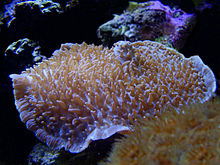Disc anemones
| Disc anemones | ||||||||||||
|---|---|---|---|---|---|---|---|---|---|---|---|---|

Discosoma sp. |
||||||||||||
| Systematics | ||||||||||||
|
||||||||||||
| Scientific name | ||||||||||||
| Corallimorpharia | ||||||||||||
| Stephenson , 1937 |

The disc anemones (Corallimorpharia) are a worldwide widespread, but only inadequately studied order of the flower animals (Anthozoa), which, in contrast to their relatives, the hard corals , lack any skeleton. Disc anemones are popular and easy to keep in the saltwater aquarium . It is a small group with currently around 24 known species .
features
Disc corals have a wide mouth disc on which there are often only very short or stunted, knob-shaped tentacles . The mouth disk merges into a narrow, sack-shaped body that ends in a foot disk with which disk anemones can attach themselves to hard substrates. Most representatives reach a size of only a few centimeters, but the "elephant ear" ( Amplexidiscus fenestrafer ) is up to 45 cm in diameter. Discosoma nummiforme , as the largest species, reaches a diameter of one meter. Tropical species are often very colorful. The animals are mostly solitary, more rarely colonial and reproduce sexually or asexually by cloning.
distribution
Disc anemones live in all seas around the world, from the Arctic to the tropics. The tropical genera such as Discosoma , Rhodactis and Ricordea mostly live in shallow water, on coral reefs that have been damaged or dead by natural disasters or anthropogenic influences . In the deeper water z. B. Corallimorphus , Nectactis and Sideractis .
nutrition
The disc anemones living in the tropical coral reefs live in symbiosis with unicellular algae, the zooxanthellae . They obtain a large part of the nutrients they need from them. Animals kept in aquariums live for years without feeding and are still multiplying. Other species, especially those that live in deep and cold water, live on zooplankton , which they catch with their tentacles covered with nettle cells . It has recently been discovered that disc anemones of the genus Pseudocorynactis eat crown-of-thorn starfish with a diameter of up to 25 cm by pulling them towards themselves and then digesting them completely.
Bare corals
A phylogenetic study from 2006 saw the disc anemones as clades of hard corals (Scleractinia) that have lost their calcareous skeleton. Some hard coral genera , including Acropora , share more apomorphies with the disc anemones than with other genera of hard corals. From this it follows that the hard corals without the inclusion of the disc anemones are a paraphyletic taxon and the disc anemones are hard corals without a skeleton, called "naked corals" by the authors of the study. The origin of the disc anemones is said to be in the Lower or Middle Cretaceous Period , 132 to 110 million years ago, when the formation of limestone was made more difficult by the decreasing pH of the seawater.
Systematics
The system of order is still fairly uncertain. So far there is no cladistic analysis of the inner group. The compilation follows Daphne Fautin et al. (2007)
- Order Corallimorpharia
Stephenson , 1937
- Family coral anemones (Corallimorphidae Hertwig , 1882 )
- Genus Corallimorphus Moseley , 1877
- Genus Corynactis Allman , 1846
- Genus Pseudocorynactis den Hartog , 1980
- Family Discosomatidae Duchassaing & Michelotti , 1864
- Genus Actinodiscus de Blainville , 1830
- Genus Amplexidiscus Dunn & Hamner , 1980
- Genus Discosoma Rüppell & Leuckart , 1828
- Genus Metarhodactis Carlgren , 1943
- Genus Paradiscosoma Carlgren , 1900
- Genus Platyzoanthus Saville-Kent , 1893
- Genus Rhodactis Milne-Edwards & Haime , 1851
- Family Ricordeidae Watzl , 1922
- Genus Ricordea Duchassaing & Michelotti , 1860
- Ricordea florida Duchassaing & Michelotti , 1860
- Genus Ricordea Duchassaing & Michelotti , 1860
- Family Sideractidae Danielssen , 1890
- Genus Nectactis Gravier , 1918
- Genus Sideractis Danielsen , 1890
- Family coral anemones (Corallimorphidae Hertwig , 1882 )
Others
The gene of a fluorescent protein of the genus Discosomas (dsRed) is used as a marker gene (partly modified) in genetically modified mice.
swell
literature
- Marymegan Daly, Mercer R. Brugler, Paulyn Cartwright, Allen G. Collin, Michael N. Dawson, Daphne G. Fautin, Scott C. France, Catherine S. McFadden, Dennis M. Opresko, Estefania Rodriguez, Sandra L. Romano & Joel L. Stake: The phylum Cnidaria: A review of phylogenetic patterns and diversity 300 years after Linnaeus. Zootaxa, 1668: 127-182, Wellington 2007 ISSN 1175-5326 Abstract - PDF
- Gruner, H.-E., Hannemann, H.-J., Hartwich, G., Kilias, R .: Urania Tierreich, Invertebrates 1 (Protozoa to Echiurida) . Urania-Verlag, ISBN 3-332-00501-4
- Hans A. Baensch / Robert A. Patzner: Mergus Sea Water Atlas Volumes 1, 4 + 5, Mergus-Verlag, Melle
- SA Fosså, & AJ Nilsen: Coral Reef Aquarium , Volume 4, Birgit Schmettkamp Verlag, Bornheim, ISBN 3-928819-05-4
- J. Ch. Delbeek, Julian Sprung: Das Riffaquarium , Volume 2, Dähne Verlag, ISBN 3-921684-45-5
- KORALLE , marine aquarium specialist magazine, No. 43 February / March 2007, Natur und Tier Verlag Münster, ISSN 1439-779X
Individual evidence
- ↑ Arthur R. Bos, Girley S. Gumanao, Franco N. Salac: A newly discovered predator of the crown-of-thorns starfish . In: Coral Reefs . Springer, Berlin / Heidelberg February 29, 2008, doi : 10.1007 / s00338-008-0364-9 (English, PDF ).
- ^ Mónica Medina, Allen G. Collins, Tori L. Takaoka, Jennifer V. Kuehl, Jeffrey L. Boore: Naked corals: Skeleton loss in Scleractinia . In: Proceedings of the National Academy of Sciences . tape 103 , no. 24 , June 13, 2006, pp. 9096-9100 , doi : 10.1073 / pnas.0602444103 ( PDF ).
- ↑ Daphne Gail Fautin, Taras Zelenchuk & Dinesh Raveendran: Genera of orders Actiniaria and Corallimorpharia (Cnidaria, Anthozoa, Hexacorallia), and their type species. Zootaxa , 1668: 183-244, 2007 PDF
- ↑ Campbell, RE, Tour O, Palmer AE, Steinbach, PA, Baird GS, Zacharias, DA, Tsien, RY. "A monomeric red fluorescent protein!" Proc. Natl. Acad. Sci. 99: 7877-82 (2001)

